 |
 |
Timeline
continued from All Heart |
 |
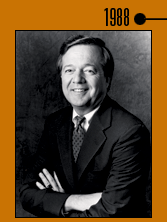 |
 |
Jeffery
Houpt
became dean, serving till 1996. The mandate to enhance
the school’s reputation in research was now going
full speed ahead. Annual research income during Houpt’s
tenure grew to almost $99 million. |
 |
 |
 |
Emory
surgeons performed Georgia’s first kidney-pancreas
transplant. The American Cancer Society moved its national
headquarters adjacent to Emory’s campus. The Emory
Eye Center performed its first vision correction surgery
with an excimer laser. |
 |
 |
 |
The
medical school helped establish a new School of Public
Health from its masters in community health program
which begun in 1975. The school was renamed the Rollins
School of Public Health in 1994, for donor O. Wayne
Rollins. |
 |
 |
 |
The
Emory University System of Health Care was formed to
bring Emory’s clinical components into one unit.
The name was later shortened to “Emory Healthcare”
This was also the year that Jonas
Shulman assumed position of dean of students
after his predecessor, Dorothy Brinsfield, retired. |
 |
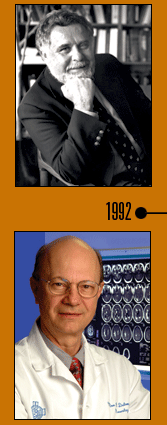 |
 |
Neurologist
Mahlon DeLong and colleagues
performed their first pallidotomy on a patient, using
brain mapping to guide placement of lesions and electrodes.
Later, state-of-the-art surgery for Parkinson’s
would shift to deep brain stimulation, involving placement
of pacemaker-like electrodes to control symptoms of
Parkinson’s and other movement disorders. This
work would help make Emory known as one of the premier
Parkinson’s centers in the world, with more movement
disorder specialists than any center in the country. |
 |
 |
 |
The
Emory Heart Center was formed to coordinate Emory’s
cardiac services at various locations under one umbrella.
The center was spearheaded by Logue Professor Wayne
Alexander and Hatcher Professor Robert Guyton and directed
by Hurst Professor Doug Morris.
This same year, Emory surgeons performed Atlanta’s
first lung transplant. |
 |
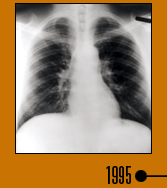 |
 |
The
Emory Eye Center was one of the few centers in the country
with approval from the Food and Drug Administration
to sponsor a study of laser-assisted in situ keratomileusis
(LASIK). |
 |
 |
 |
The
Robert W. Woodruff, Joseph B. Whitehead and Lettie Pate
Evans foundations created and funded the Robert W. Woodruff
Health Sciences Center Fund with grants of Coca-Cola
stock totaling $295 million. Income from the fund was
dedicated to development of the Health Sciences Center
and the Winship Cancer Institute. |
 |
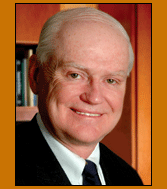 |
 |
This
same year, Executive Vice President for Health Affairs
Michael Johns appointed acting dean Thomas
J. Lawley to the deanship. He has presided over
unprecedented growth in research space, grants,and collaborative
partnerships. |
 |
 |
 |
Emory
doctors performed the world’s first minimally
invasive triple “keyhole” off-pump coronary
artery bypass surgery, using mini-CABG instruments. |
 |
 |
 |
This
same year, Emory surgeons performed the state’s
first split living-related liver transplant, from mother
to son.
Emory surgeons also successfully split a donated liver
into two portions and then transplanted the left lateral
segment into a 21-month old girl and the larger portion
into a 42-year old woman.
Emory doctors implanted the first biventricular pacemaker
in Georgia. |
 |
 |
 |
The
NIH designated Emory as one of three Parkinson’s
Disease Research Centers of Excellence. also in 1998,
Emory doctors performed the world’s first unrelated
umbilical cord blood transplant for sickle cell anemia
on a 12-year old boy at Egleston Children’s Hospital.
This same year, Georgia Tech and Emory created the first
joint, two-school Department of Biomedical Engineering
in the country.
Also this year, Emory clinicians began the use of virtual
reality devices to treat debilitating fear of flying
and later, post-traumatic stress disorder. |
 |
 |
 |
Emory
doctors implanted Georgia’s first dual-pump ventricular-assist
device. |
 |
 |
 |
This
same year, Emory dedicated a four-story, 75,000-square-foot
Vaccine Research Center, directed by Rafi
Ahmed, a Georgia Research Alliance Eminent Scholar
in vaccine research. |
 |
 |
 |
Emory
doctors implanted drug-eluting stents in clogged arteries
as part of landmakr studies to see if the devices reduced
incidence of restenosis. |
 |
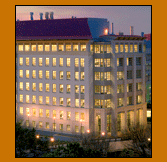 |
 |
Also
this year, the Whitehead Biomedical
Research Building opened, built with funds from
the family of foundations whose patriarch, Joseph B.
Whitehead, was the first to sell Coca-Cola in bottles. |
 |
 |
 |
Based
on an Emory gene discovery, the FDA approved a protein
stimulating bone growth to provide an alternative to
painful bone grafts. |
 |
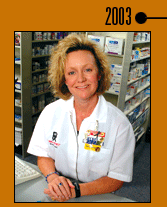 |
 |
Emory
doctors Chris Larsen and Thomas Pearson performed Georgia’s
first islet cell transplant to cure diabetes. The patient,
a 42-year old pharmacist, had had diabetes since
the age of 8. |
 |
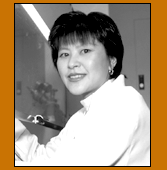 |
 |
Also
this year, the Winship Cancer Institute (WCI) dedicted
a new 280,000-square-foot building, integrating cancer
clinicians and cancer researches (sometimes embodied
in the same person, like Lily
Yang) under the same roof for the benefit of
patients. WCI also received a planning grant from the
National Cancer Institute, a crucial step towards WCI’s
goal of NCI designation as a “comprehensive”
cancer center. The seed that Robert Woodruff planted
in 1937 with his $50,000 gift for a cancer clinic had
now grown into a sturdy tree, its branches reaching
for the sky.
This same year, continuing a tradition of innovations,
Emory clinicians performed the country’s first
artificial cornea transplant, the world’s fifth
nonsurgical repair of a faulty mitral valve, and Georgia’s
first endoscopic, closed-chest, off-pump cardiac bypass. |
 |
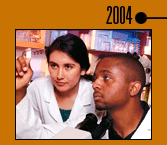 |
 |
The
Department of Biomedical Engineering, only six years
in existence, was ranked second in the nation by US
News & World Report. |
 |
| |
|
|
| |
|
|
| |
|
|
|
|
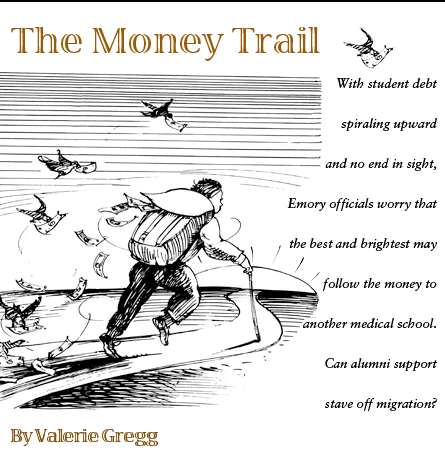 |
 |
John
S. Inman Jr., 45M, came into the world upside down, a breech
birth, delivered at home in his parents’ bed by their
family doctor, who charged $25. It was 1921, before Albany,
Georgia, was laid low by the Great Depression, and $25 was
a large, but manageable sum for a small-town businessman.
Inman’s father never forgot the doctor that saved the
life of his son and wife, and this homespun birth story was
recounted often during Inman’s childhood.
As he grew, Inman dreamed of becoming a doctor, and after
graduating from Emory College in 1942, he entered the Emory
School of Medicine. “I was blessed,” he says.
“The Army paid two years of tuition, and my father paid
for one year. When I graduated, I didn’t owe a penny.”
Indeed, times have changed. The average education debt today
is $135,000 for graduates of private medical schools and $100,000
for public medical school graduates, according to a recent
report by the Association of American Medical Colleges (AAMC)
on medical school tuition and young physician indebtedness.
By contrast, in 1984, private medical school students graduated
with an average debt of $27,000 and public medical school
students with a $22,000 average debt burden. That means that
medical education debt is 4.5 times higher in 2004 than in
1984. The average tuition and fees is 2.7 times higher in
private medical schools and 3.8 times higher in public medical
schools, according to the report.
While many medical students justify the cost of an Emory education
because they know it will pay off in the long run, too many
others follow the scholarship money to schools with a broader
base of alumni involvement and support. Then Emory loses great
students who want to come here but can’t afford it.
At private schools like Emory, more than a third of graduates
now owe more than $150,000. Ten years ago, the average Emory
medical student owed about $50,000 by graduation. The problem
is simple—tuition has risen, and scholarship money has
not kept pace. Although about 75% of medical students at Emory
receive some form of financial aid, it’s often a drop
in the bucket in light of an annual tuition of approximately
$30,000. Meanwhile, physicians’ salaries are stagnant
or falling because of inadequate reimbursement, particularly
for certain specialties (pediatrics, internal medicine, family
practice, obstetrics/gynecology), and rapidly rising malpractice
insurance premiums, thereby making it more difficult for recent
graduates to shoulder large student loans.
School of Medicine Dean Thomas Lawley has made increasing
scholarship assistance a fund-raising priority. At every opportunity,
he asks alumni to support scholarships, hoping to double the
funds available for medical students. Indeed, Lawley himself
has pledged $5,000 to the scholarship fund recently established
by the Emory School of Medicine Class of 1972, the year he
graduated from medical school.
“A heavy debt burden means that our students, as soon
as they are able, have to go out and make money,” Lawley
says. “They can’t go into academic medicine, they
can’t do research, and they can’t go into an indigent
care situation. That is simply wrong.” |
 |
| |
|
|
 |

Inman feels grateful he was able to follow his calling–delivering
babies in his hometown. He has delivered 10,000 babies during
his career, earned enough to send two sons to Emoryboth to
Emory College and one to the School of Medicine as well. He
says he–continues to have a great career even though
he no longer delivers babies.
Having no school debt to pay off helped immeasurably, he says,
so he spent two years in the Army and four years in residency
before coming home to practice obstetrics and gynecology.
His father helped set him up in practice in Albany, but after
four or five months, he was on his own.
“My education at Emory made everything possible for
me,” he says. “Emory gave me the best start in
terms of medical education and has continued to be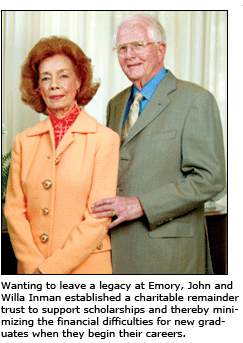 important to our family throughout my life.”
important to our family throughout my life.”
Inman knew he wanted to leave a legacy at Emory, and when
he heard about today’s debt situation, he decided to
help. He has contributed a substantial amount of money to
support student scholarships by establishing a charitable
remainder trust, in which stock will establish endowed scholarships
for medical students who train at Emory after he and his wife
have died.
He hopes his gift will encourage more young people to become
physicians to partake of the profession’s rewards and
minimize the financial difficulties as graduates enter the
practice of medicine. Many medical school admissions officers
worry that top graduates who in the past would have chosen
medicine may opt for different career paths. The rising tide
of debt also unduly influences their choice of specialty.
The potential modest future income for primary care physicians
has probably already been a major factor in the recent decrease
in medical students choosing this specialty.
“If we don’t increase our level of scholarship
support for students, we’re going to start losing the
best and brightest applicants to other medical schools, if
not to other professions,” says Joel Felner, associate
dean for education at the School of Medicine. “We simply
don’t have as much scholarship support to offer as our
peer schools like Washington University, Vanderbilt, and Duke.”
Tom Duke, 45C, 43M, hopes his recent commitment will offer
students from impoverished backgrounds a chance to become
physicians and give back to their communities. He himself
grew up in the small town of McRae, Georgia, in a family of
moderate means. |
 |
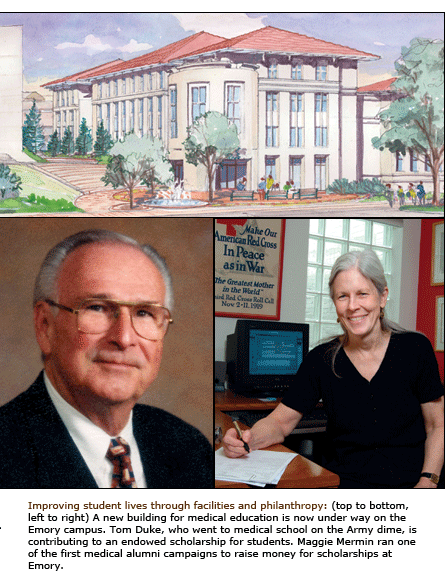 |
 |
“I
would have been hard pressed to pay tuition if I hadn’t
been part of the Army Specialized Training Program as a World
War II veteran,” he says. “I can understand the
needs the students have at this time, and I want to help them,
particularly minority students.”
To that end, he has committed $2.25 million in trust for an
endowed scholarship fund. Duke acknowledges that his days
at Emory opened doors to high places for him. During his career,
he practiced medicine at Yale and the University of California
at San Francisco, and he studied cardiology in Great Britain.
After many years of practice in Amarillo, Texas, he has retired.
Even though Duke had no debt to worry about after graduation,
it was plenty hard to make ends meet. He spent long, grueling
summers during his residency as a country doctor in south
Georgia, working in a poorly equipped office, driving many
miles along dusty roads to see patients in their homes, and
often treating patients who couldn’t pay a dime.
When reflecting on his long and satisfying medical career,
he says that the intangible aspects of medical practice made
it all worthwhile. “The practice of medicine is sometimes
tiring, sometimes boring, sometimes dramatic, and for the
dedicated physician, it is always satisfying,” he writes
in a memoir about his summers in south Georgia. “That
satisfaction sometimes comes when it is least expected.”
Duke hopes medical students today will feel the same way when
they retire years from now. And he hopes his gift will encourage
young doctors-to-be to hang in there when the financial going
gets rough. |
 |
| |
|
|
 |

As
the clinical revenues that have traditionally supported medical
education have fallen off due to the pressures of decreased
reimbursement through Medicare, Medicaid, and managed care,
tuition costs have risen along with the cost of educating
physicians and practicing medicine in general.
Further complicating matters, medical schools must adhere
to small class sizes to meet AAMC accreditation requirements,
as well as to teach subject matter effectively. Emory is accredited
for no more than 114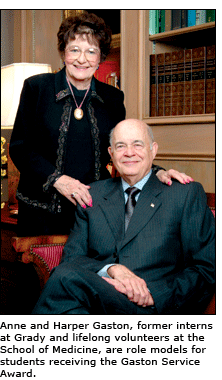 medical students per incoming class. That leaves medical schools
without the income generating solutions of increasing class
size that law and business schools have.
medical students per incoming class. That leaves medical schools
without the income generating solutions of increasing class
size that law and business schools have.
Although Emory’s endowment has done well in the past
20 years, much of the income it generates is earmarked for
restricted uses. The famed Woodruff Scholarships, which offer
full tuition and a stipend to a select group of medical students,
are awarded to only four or five medical students in each
class. Although other scholarships are available, most cover
only a small portion of tuition. The average medical student
at Emory receives significantly less scholarship money than
students at comparable medical schools. With student debt
spiraling upward and no end in sight, Emory officials worry
that potential students may follow the money to another medical
school. |
 |
| |
|
|
| |
 |
|
 |
Margaret
Mermin, 77M, knows the financial sacrifices of attending Emory
School of Medicine are worth it in the end. Attending medical
school and completing her residency at Grady while putting
her own children through private school left her hard-pressed
to pay tuition. Student loans and remortgaging her house paid
her way. But her education has given her the career she was
meant to have, and she believes it is important to continue
supporting the school, running one of the first alumni scholarship
campaigns in the early 1990s. She urges her fellow Emory alumni
to support scholarships, because the alternative is unacceptable.
“I fear that only the children of the richest and poorest
parents will get to go to medical school in the future because
tuition is now so high,” she says. “That would
be terrible for our society. Also, we don’t want our
Emory graduates to choose specialties with an eye to paying
back loans instead of following their true interests and serving
the community. That’s not what Emory is about.”
One of the most enthusiastic couples to graduate from the
School of Medicine, Anne Elizabeth Hendrick Gaston and J.
Harper Gaston IV, both 55M, couldn’t agree more. Both
are individual recipients of the Medical Alumni Association
Award of Honor and the Emory Medal and are dedicated volunteers.
For the past 10 years, they have sponsored the Gaston Service
Award Scholarships. Recipients must be accomplished scholars
and have a track record of community service in high school,
college, and medical school. Recent recipients have developed
service organizations within the medical school, founded a
statewide coalition of health professional students, coordinated
volunteers for clinics for the homeless, taught and mentored
children, and participated in volunteer health services activities
throughout the world.
Serving others is the heart of medical practice, says Harper
Gaston. “It’s a different world now in medicine,
and although the financial rewards are not be what they used
to be, service in and of itself is the greatest reward that
our profession can offer us. It is the heart of medicine.
I hope our scholarships will encourage young people to say
yes to volunteerism.” The Gastons decided that scholarships
within the medical school would be the best way for them to
make a modest payback for what they have received. “We
both have had incredible careers and attribute much of that
to our experiences at Emory.”
The Gastons have given their time and energy to the medical
school for more than 50 years. They served as co-chairs of
the National Council of Medicine and are current members of
the school’s Advisory Council. Throughout their careers,
both have devoted at least half a day a week to education
and other volunteer activities. Harper Gaston was an adviser
for several years to the Emory University System of Healthcare
Board of Directors and a member of the Emory Board of Visitors.
In addition to being a leader in the Kaiser Permanente Medical
Care program, he was involved in the California Heart Association
for almost 20 years, including serving as president.
Anne Gaston was a founding member and president of the Association
of Emory Alumni (AEA), and she served as an elected member
of the Emory’s Board of Trustees. She was the first
female president of an Emory medical school class and one
of only two women in her class. Devoted to improving health
care for children both as a neonatologist and pediatrician
in northern California, she volunteered weekly throughout
her career, teaching medical students and residents at the
University of California–San Francisco, where she became
professor of pediatrics in 1979.
“We believe that community involvement broadens all
of us and allows us to continue to grow and to contribute
to the common good,” she says. “The common good—that’s
what being a doctor is all about.”
To make a gift to Emory School of Medicine, contact Phil Hills,
senior associate vice president for health sciences development
and alumni affairs, at 404-727-7511, or phills@emory.edu.
Or make a gift online at https://www.alumniconnections.com/donate/emory/medical.html
Valerie Gregg
is a freelance writer in Atlanta and a former staff member
of the Woodruff Health Sciences Publications office.
|
 |
| |
|
|
| |
|
|
 |

Emory
School of Medicine's 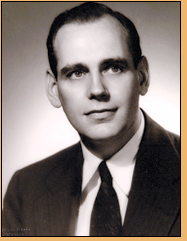 need
for more scholarship funds is not a new problem, as
evidenced by this memory from alumnus Eugene Stead,
dean and Department of Medicine chairman at Emory as
well as a great leader in medical education (see
A Marriage Made in Atlanta timeline) "I
have always been grateful for Emory, my alma mater.
This small, struggling college had the audacity to attach
to itself a failing proprietary medical school. At the
time I entered, it was on and off the probation list.
It was 1928 and the Great Depression had already begun
in the South. The only question anyone asked when I
applied for admission was, "Son, can you borrow
the money for tuition?" I said that the Atlanta
Rotary Club would lend me the money. Each year I cheerfully
send Emory a check. No Emory medical school, no Dr.
Eugene Stead." need
for more scholarship funds is not a new problem, as
evidenced by this memory from alumnus Eugene Stead,
dean and Department of Medicine chairman at Emory as
well as a great leader in medical education (see
A Marriage Made in Atlanta timeline) "I
have always been grateful for Emory, my alma mater.
This small, struggling college had the audacity to attach
to itself a failing proprietary medical school. At the
time I entered, it was on and off the probation list.
It was 1928 and the Great Depression had already begun
in the South. The only question anyone asked when I
applied for admission was, "Son, can you borrow
the money for tuition?" I said that the Atlanta
Rotary Club would lend me the money. Each year I cheerfully
send Emory a check. No Emory medical school, no Dr.
Eugene Stead."
-From The Quest for Excellence: The
History of the Department of Medicine at Emory University
School of Medicine, 1834-1986, by J. Willis Hurst |
 |
| |
|
|
|
| |
|
|
|





